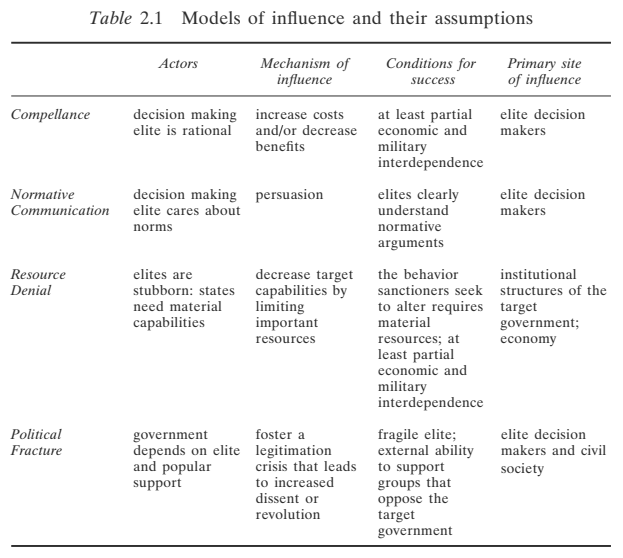Chapter 7 Sanctions Consequences (Week 7)
7.1 Discussion questions
Grauvogel et al. (2017): What is the main argument of this paper? What lessons can we learn from this paper concerning improving the effectiveness of sanctions? How can we improve this research?
Peksen & Drury (2010): According to the authors, how do sanctions corrode targets’ democracy? What counterarguments can you offer?
Do sanctions destablize target countries’ leaders? (*)
Cuba blames US as the country sees biggest protests in decades | DW News
7.2 Motivation
Recall the mechanisms of sanctions. Crawfold and Klotz (1999, 27) contends there are four general mechanisms of sanctions. See below for their table.

Allen (2008) JCR argues that sanctions may increase political violence/antigovernment activities in target countries. But the effects are smaller in autocracies. This is because “autocratic states, leaders may actually benefit from sanctions, as domestic publics are unable to impose political costs and the economic constraints of sanctions often allow leaders to extract greater rents while overseeing the trade of scarce goods” (Allen 2008, 917). Allen (2008) FPA offers a similar argument that autocracies are less constrained “as they can shunt the costs of sanctions off onto the general public”. Therefore, sanctions on autocracies are less likely to be successful.
Lektzian and Souva (2007) argues sanctions work by the punishment mechanism. Economic harms can translate into political pressure as deprived citizens are more likely to challenge the existing regime. Autocracies can better tap into the economic rents created by sanctions. Also, they have a smaller size of winning coalition (i.e. core constituents). Therefore, they are more capable of insulating their core supporters from the economic harms.
7.3 Grauvogel et al. (2017)
Grauvogel et al. (2017) offer a different perspective. In particular, the above theory cannot explain well cases where protests happen before or without actual economic harms. They instead argue for a signaling/perception mechanism. International sanctions signal to the potential protesters and opposition groups that they will have international approval and support. Hence, sanctions create perceived opportunities for these protesters.
One clever and critical part of their arguments hinges on the distinction between sanction threats and sanction impositions. They argue that sanction threats entails the messages/signals to domestic groups. In contrast, sanction imposition relies on the punishment mechanism. Interestingly, they take a step further here by arguing that the latter mechanism does not increase protests. This is attributed to the following countervailing process:
- Sanction imposition can create rally-’round-the-flag effects, allowing ruling elites to drum up the nationalist sentiments.
- Shifting economic difficulties from supporters to opposition groups.
- Scapegoating sanctions for economic and political problems, which undermines opposition mobilization.
This is reasonable and previous research has also argued along similar lines (Lektzian 2007 JCR). However, one may wonder to what extend is this process unique to sanction imposition.
Now turning to the empirics, it would be interesting if you can locate their replication files and examine how they conduct their analysis (to be sure, they do provide a word document here). In particular, it is not very clear to me how they construct their dependent variable and how they justify they choices. In p.89 second paragraph, they talk about how they count monthly protests after sanctions. Now, suppose there is a new sanction threat or imposition on 30 October and there is no new sanctions in November, do they count the protests in November as stemming from sanctions or not? If I read it correctly, their answer is no. But if so, it is not very clear why this is justified.
Second, it would be very interesting to rerun their analysis separating the threat and imposition variables. Again, I cannot find their replication files. But if you can, it is worth rerunning their analysis given the concern of post-treatment bias. See here for some introductory notes:
- Be careful not to control for a post-exposure covariate
- Another reason to be careful about what you control for
- Why you shouldn’t control for post-treatment variables in your regression
See here for a more detailed research paper: How Conditioning on Posttreatment Variables Can Ruin Your Experiment and What to Do about It
Now, taking a step back, let us think about the works by Allen, Lektzian, and Souva. If sanctions do trigger protests via the signaling mechanism, should we expect any differences between autocracies and democracies?
7.4 Peksen & Drury (2010)
Peksen & Drury (2010) contend that instead of coercing target states, sanctions inadvertently corrode targets’ democracy. This is because sanctions open up new opportunities for leaders to reallocate resources from potential opponent groups to their supporters. Therefore, “as sanctions inadvertently allow leaders to augment the ties between powerful groups and themselves, while disproportionately hurting anti-regime groups, targeted regimes become more authoritarian and intransigent” (p.245-246).
Additionally, conceding to foreign threats will generate audience costs, which in turn make target leaders less conciliatory while offering them with more excuses to repress. Building on previous studies that contend sanctions can signal international support and increase protests and political violence, they argue that leaders would likely ramp up repression in response.
Note that the mechanism hinges heavily on opposition groups’ incentives to protest and incumbents’ choices to repress. But does this necessarily lead to an erosion of democracy? Soest & Wahman (2015), for instance, argue that sanctions can actually promote democracy in target states as they can destabilize authoritarian rule.
Relatedly, their theory seems to work better for autocracies. So in may be interesting to restrict the sample to autocracies or anocracies (if you buy into their argument concerning why they take out consolidated democracies, see p.248) in their research design. It would also be interesting to theorize and examine whether their theory is contingent on regime types. Finally, the dynamic process and the long-run effects could also be further teased out.